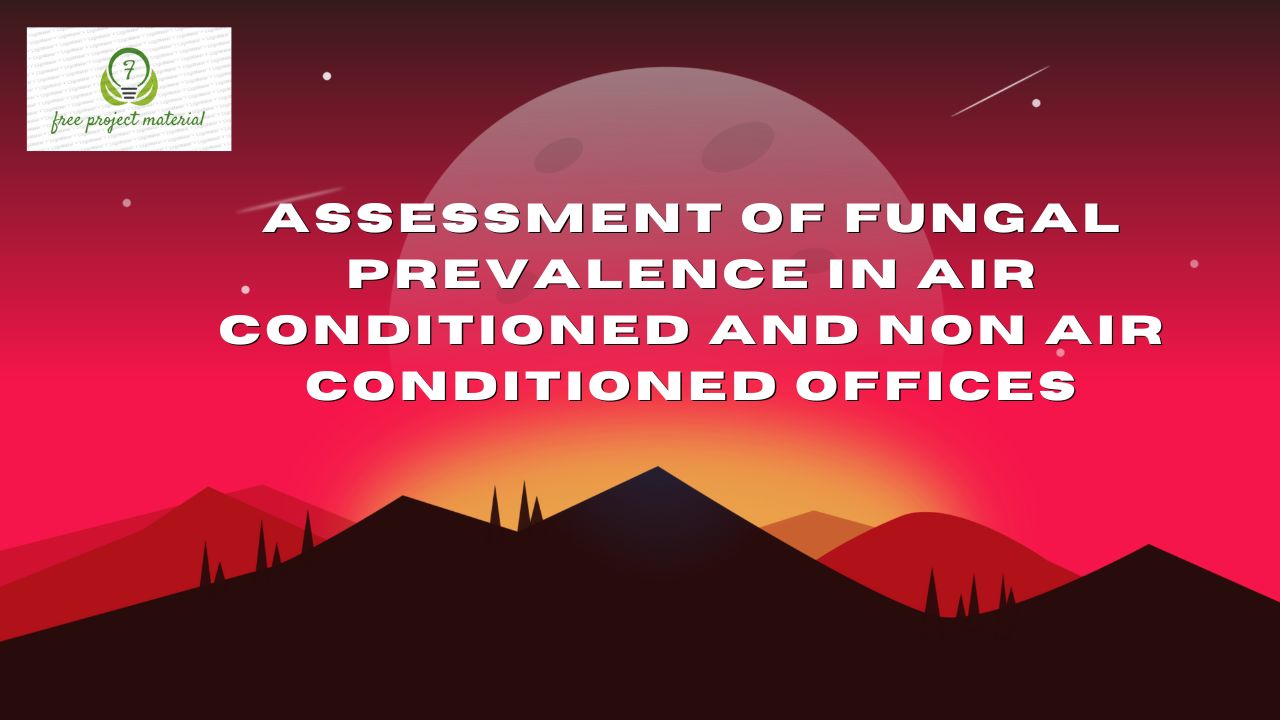ABSTRACT
The aim of this study was to investigate the fungal prevalence in air conditioned and non-air conditioned offices in Akwa Ibom State Polytechnic. Ten (10) offices each of air conditioned and non-air conditioned were sampled proper aseptic techniques and procedures were carried out in order to obtain accurate result according to standard techniques. The results of the study revealed that non-air conditioned offices had the highest fungal count of 3.7 cfu/m3 while the least fungal counts was observed in air conditioned office. Furthermore, Aspergillus had the highest percentage frequency of occurrence (33.3%) and Epidermophyta had the least counts (6.6%). The fungal isolates recorded in this study were: Aspergillus, Clasdosporium, Fusarium, Epidermophyta and Rhizopus sp. From the result of this study it can be concluded that though the offices in Akwa Ibom State Polytechnic is compose of some fungal species but the level of is not detrimental to human health. However, It is recommended that air conditioner be installed in all offices, probably this could help to retard the prevalence of fungal pathogen in the environment. Also, regular and proper cleaning of the offices should be maintained to avoid accumulation of fungal spores that could transform to harmful pathogens.
TABLE OF CONTENTS
Title page- – – – – – – – – – i
Certification- – – – – – – – – ii
Dedication- – – – – – – – – – iii
Acknowledgements- – – – – – – – iv
Abstract- – – – – – – – – – v
Table of contents- – – – – – – – – vi
CHAPTER ONE
1.0 Introduction – – – – – – – – 1
1.1 Background of the Study – – – – – – 1-5
1.2 Aim and Objectives of the Study – – – – 5
1.3 Scope and Limitations of the Study – – – – 6
CHAPTER TWO
2.0 LITERATURE REVIEW
2.1 Indoor Air Quality – – – – – – – 7-9
2.2 Fungal Pollution of Indoor Environments – – – 9-11
2.2.1 Health Hazards of Indoor Fungi – – – – 11-12
2.2.2 Respiratory Symptoms – – – – – – 12-13
2.2.3 Hypersensitivity Syndromes – – – – – 13-14
2.2.4 Respiratory Infections – – – – – – 15
2.2.5 Rhematologic and Other Immune Diseases – – – 15-16
2.2.6 Allergy – – – – – – – – 16-18
2.3 Fungal Constituents of Indoors – – – – – 18
2.3.1 Volatile Fungal Metabolites – – – – – 18-19
2.3.2 Ergosterol – – – – – – – – 19-20
2.3.3 Mycotoxins – – – – – – – – 20-22
2.4 Factors Influencing Fungal Colonization – – – 22-23
2.5 A Review of Indoor Air Quality Assessment – – – 23-26
CHAPTER THREE
3.0 MATERIALS AND METHODS
3.1 Materials – – – – – – – – 27
3.1.1 Reagents – – – – – – – – 27
3.2 Methods – – – – – – – – 27
3.2.1 Sample Collection – – – – – – – 27-28
3.3.2 Macroscopic Examination of Fungal Isolate – – – 29
3.3.3 Purification of Fingal Isolate – – – – – 29
3.3.4 Microscopic Examination of Fungal Isolate – – – 29-30
CHAPTER FOUR
4.0 RESULTS AND DISCUSSION
4.1 Results – – – – – – – – 31-33
4.2 Discussion – – – – – – – – 34-37
CHAPTER FIVE
5.0 CONCLUSION AND RECOMMENDATIONS
5.1 Conclusion – – – – – – – – 38
5.2 Recommendations – – – – – – – 39
References
CHAPTER ONE
INTRODUCTION
1.1 Background of the Study
Air quality of indoor environments is one of the main factors affecting health, wellbeing and productivity of people (Hayleeyesus and Manaye, 2014). One of the problems of indoor air quality is affected by the presence of microorganisms which include bacteria, moulds and viruses (WHO, 2009a). People’s exposure to indoor air pollution is determined by the concentrations of pollutants in the indoor environment and, most importantly, by the time individuals spend in polluted environments. Since, more than 90% of people spend majority of their time indoors by breathing on average 14 m³ of air per day (Brochu et al., 2006), therefore, good air quality is of utmost importance. Poor indoor air quality can pose problems that can be subtle and do not always produce easily recognizable impacts on the health and welfare of populations (USEPA, 2006).
Several effects on the respiratory system have been associated with exposure to IAP including asthma development, asthma exacerbation, respiratory infections, upper respiratory tract symptoms, cough, wheeze and dyspnoea (WHO, 2009a; Hayleeyesus and Manaye, 2014). Therefore, indoor air quality is of special concern for students and workers, particularly those sensitive to poor air quality as today’s higher institutions can be regarded as ‘‘mini cities” with large territorial coverage, diverse human activities, with different degrees of effect on the environment (Alshuwaikhat and Abubakar, 2008).
Since air is an important vehicle for the dissemination of infectious agents and allergic components, developing potential undesirable effects on human beings, the control of the microbial charge has become an important key to define the environmental quality of ambient media surrounding human populations that are largely exposed to indoor air during their daily activities (Soto et al., 2009). The air quality inside buildings is affected by many factors. In an effort to conserve energy, modern building design has favoured tighter structures with lower rates of ventilation (Ezzati and Kammen, 2001). By contrast, in some areas of the world only natural ventilation is used; in other areas mechanical ventilation is common. Factors that can have a negative effect on health and comfort in buildings range from chemical and biological pollutants to occupant perceptions of specific stresses such as temperature, humidity, artificial light, noise and vibration. Air pollution is believed to kill more people worldwide than AIDS, malaria, breast cancer, or tuberculosis (WHO, 2009b).
The increase in commercial activities in our University environment as well as the functioning of machinery in several business units, and an unquantifiable amount of emissions are now of concern especially from the burning of fossil fuels, poor building designs and poor ventilations. Also, recent developments in construction materials have resulted in the use of more synthetics and composites, which can affect air quality. Radical changes in technology have led to innovations, such as air conditioners, computers and photocopiers that provide greater efficiencies and time savings, but can also affect the quality of indoor air (Franklin, 2007). These potentially adverse effects are further complicated by the fact that people are spending more time than ever indoors. Thus, indoor air quality (IAQ) is an important criterion that must be taken into account when indoor workplaces are designed to provide a safe environment. Good IAQ is an interaction of efficient ventilation and the lowest achievable amounts of chemical, inorganic or organic and microbial compounds which shouldn’t evoke symptoms in the occupants (Yamashita et al., 2005).
Bacteria, fungi, pollen, viruses, rat droppings, mites, insect body parts or bird droppings can be sources of biological contamination (Nevalainen and Seuri, 2005; Khan and Karuppayil, 2010). The indoor bacterium – Legionella causes both Legionnaire’s Disease and Pontiac Fever (Nakayama and Morimoto, 2007). Common contributors to biological pollutants are water damage to homes during flooding or storm damage, leaks in plumbing, roofs or air conditioners, dehumidifiers, humidifiers, and bathrooms; and ice damming on building roofs allows water to seep through the roof sheathing (Cunningham et al., 2004; Mc Kernan et al., 2008). Humidifiers in the ventilation circuit provide place for proliferation of microorganisms (Farley and Franklin, 1992; Yamashita et al., 2005; Li et al., 2010).
The design and operation of Heating, Ventilation and Air Conditioning systems (HVAC’s) have an impact on the distribution of air borne infectious organisms (Mc Grath et al., 1999).
1.2 Aim and Objectives of the Study
The aim of this study was to carry out the assessment of fungal prevalence in air-conditioned and non-air conditioned offices in Akwa Ibom State Polytechnic.
The objectives of this study are as follows;
- To determine the fungal load of the air environment of some air conditioned offices in Akwa Ibom State Polytechnic.
- To investigate the fungal prevalence in some none-air conditioned offices in Akwa Ibom State Polytechnic.
- To make useful recommendation base on the result of this study.
- To compare the fungal load with the permissible limits of some standards.
1.3 Scope and Limitation of the Study
This study is focused on the assessment of the prevalence of fungal in air-conditioned and non-air conditioned offices in Akwa Ibom State Polytechnic. This study was limited due to time, lack of appropriate machines and equipment and financial constraints.


